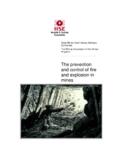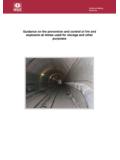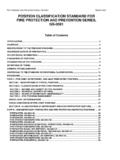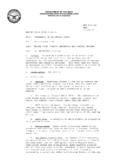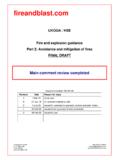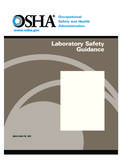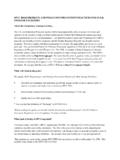Transcription of WISH
1 wish Waste Industry Safety and Health Forum REDUCING fire RISK AT WASTE. MANAGEMENT SITES. This guidance is good practice guidance. Parts of it may go further than is needed to achieve legal and regulatory compliance. Waste management operators must first comply with applicable law and regulation, regulatory standards, and the requirements of their permits, licences and similar permissions. This is the second edition of the wish Reducing fire Risk at Waste Management Sites'. guidance, the first edition having been released in October 2014. As for its predecessor, this revised guidance is aimed at providing waste management operators with the advice and information required to: Reduce the likelihood and frequency of fires at solid waste management sites Where fires do occur, reduce the potential safety, health, environmental, property damage and business interruption impacts Production of this guidance was facilitated via the wish Waste Fires Working Group.
2 Representation on the working group included the following organisations: CIWM (Chartered Institution of Wastes Management). CFOA's (Chief fire Officers Association) National fire Chiefs Council (NFCC). ESA (Environmental Services Association). EA (Environment Agency). HSE (Health and Safety Executive). PHE (Public Health England). WRA (Wood Recyclers Association). TRA (Tyre Recovery Association). Other organisations were also consulted on specific aspects, such as some of the main insurers involved in waste management on fire engineering issues, and other bodies were corresponding participants. WASTE 28 Reducing fire risk at waste management sites issue 2 April 2017 1 of 166. Waste Industry Safety and Health Forum Involvement in the working group does not imply an organisation's agreement with all aspects of this guidance. The aim of the working group was to hold an open and informed debate on waste site fire risk to arrive at the best, good practice methods of mitigating this risk.
3 wish . believes that this guidance represents best, good practice. This guidance is supported by CFOA's (Chief fire Officers Association) National fire Chiefs Council (NFCC), the Environmental Services Association (ESA), the Chartered Institution of Wastes Management (CIWM), the Scottish Environment Protection Agency (SEPA), Natural Resources Wales (NRW), and the Waste Industry Safety and Health Forum ( wish ). Future guidance from sector specific bodies, or regulators, on specific waste technologies and/or specific wastes may impose higher standards. wish would welcome the development of such specific guidance. Where such sector guidance is produced, and where appropriate, future revisions of this guidance may include signposts to such documents. If you are in any doubt about the standards which apply to your circumstances you should seek the advice of your regulators. You must always comply with regulatory standards and guidance.
4 It is not the intent of this guidance to be inflexible, and options and considerations have been given throughout to allow operators to tailor it to their circumstances. Nor is it the intent to provide a one-stop-shop for waste management and similar sites on fire risk existing guidance and standards on general fire management and control, in particular on life-safety, should be read in conjunction with this guidance. It is the intent of this guidance to provide a framework through which operators can reduce the risk of fire on their sites and minimise the business and societal impacts of any fires that do occur. This guidance is intended as an umbrella document: It gives advice applicable to a wide range of waste management and similar sites which handle solid combustible wastes, but it cannot cover every aspect of all forms of waste management operation. Operators need to be aware of relevant other guidance and standards, and of the need for specific assessment to tailor solutions to their specific situation and operations.
5 As knowledge develops and as better information becomes available, further revisions of this guidance will be made to keep it up to date. WASTE 28 Reducing fire risk at waste management sites issue 2 April 2017 2 of 166. Waste Industry Safety and Health Forum Contents For ease of reading this guidance is split: The first part covers general issues such as scope and fire risks. The second part provides specific guidance for waste management sites in four areas: Whole site issues, issues in waste reception, during waste treatment and for the storage of wastes. Appendices are also included on issues such as external storage, fire engineering and checklists to help you assess if your fire control is adequate. To aid readers in seeing what has changed since the 2014 version of this guidance, a summary of main changes is provided at the start of each section, in green italic text.
6 1. Introduction and scope wish waste fire guidance version II what has changed Waste burn trials 2015 and 2016. Risks of fires Scope of this guidance Regulators Insurers Plans and assessments Technical standards 2. Whole site considerations Protection of human life Location and neighbouring sites/businesses/environment General ignition sources, causes of waste fires and precautions Housekeeping and dusts Heavy mobile plant Hot works Site/plant shut-down processes Water supplies Contaminated firewater Detection, alarm and suppression systems - overview Non-waste facilities on site fire appliance access Communication, training and drills WASTE 28 Reducing fire risk at waste management sites issue 2 April 2017 3 of 166. Waste Industry Safety and Health Forum 3. Waste reception Hot wastes and other hazards in reception fire detection, alarm and suppression/extinguishing systems at reception areas.
7 Specific considerations Other considerations in reception 4. Waste treatment and processing General ignition risks in processing Shredders, bag openers and similar Trommel screens, other screens, air-separators and similar Mechanical handling systems, conveyors etc Balers and similar De-dusting systems, cyclones etc Mains/electrical plant rooms and control panels Picking cabins General considerations in processing areas fire detection, alarm and suppression/extinguishing systems in processing areas . specific considerations Protecting your plant by separation/segregation and plant close-down 5. Waste storage general considerations Definitions of terms used in storage sections and appendices Safe storage capacity Bunkering/enclosing waste storage with firewalls as an alternative to limiting fire spread by distance Self-combustion and storage times Baled wastes specific storage configuration issues 6.
8 External waste storage Overall considerations fire , detection and fire systems in external storage areas Vandalism and other specific ignition threats in external storage WASTE 28 Reducing fire risk at waste management sites issue 2 April 2017 4 of 166. Waste Industry Safety and Health Forum 7. Internal waste storage Overall considerations fire detection and fire systems in internal storage areas Application of appendix 1 on externally stored wastes to internally stored wastes 8. Disclaimer Appendix 1: External storage of wastes 1. Introduction and waste stack management 2. Factors affecting stack separation distance and the use of fire walls 3. Factors affecting stack dimensions 4. Option 1 - standard stack dimensions and separation distances 5. Option 2 - modified/bespoke stack dimensions and separation distances 6. Examples of stack layout Appendix 2: Producing an accident/emergency plan Appendix 3: Checklists to help you manage fire risk at your site Appendix 4: fire /risk engineering and waste management plants 1.
9 Design of fire systems 2. fire detection 3. fire alarm 4. fire suppression/extinguishing/fighting systems 5. Water demand, supply and water mains 6. Other factors Appendix 5: Useful links and further reading Appendix 6: Glossary Tips throughout this publication you will find tips' in text boxes. These are from the experience of various waste management operators and other persons. They should not be considered part of formal guidance and are there simply to provide informal advice. They are intended to inform and share knowledge and you should consider these tips in the light of your own site specific requirements and your own individual situation. WASTE 28 Reducing fire risk at waste management sites issue 2 April 2017 5 of 166. Waste Industry Safety and Health Forum 1. Introduction and scope Summary main changes from 2014 guidance: A new section outlining changes made since 2014 has been added below, including what these changes are based on, a summary of the waste burn trials conducted in 2015 and 2016 and some detail changes and additions.
10 fire is an ever-present possibility at most waste management sites, if only because many wastes are readily combustible. Operators should therefore ensure they have adequate controls in place to prevent fires and, should a fire occur, that the risks to human health, property and the environment are minimised. This guidance aims to give an overview of fire safety management on solid waste management sites (see scope in section ). It is not the intent to provide a comprehensive guide on all aspects of fire safety, to duplicate general fire management guidance which is available elsewhere or to provide in-depth technical advice. It is your responsibility to ensure that your management of fire safety is adequate. For guidance on sources of competent advice see the glossary section of this guidance under competent advice'. wish waste fires guidance version II (what has changed?)


